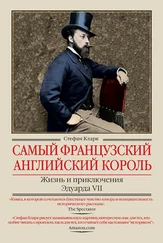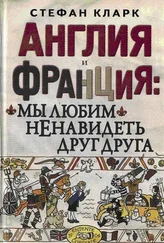Стефан Кларк - 1000 Years of Annoying the French
Здесь есть возможность читать онлайн «Стефан Кларк - 1000 Years of Annoying the French» весь текст электронной книги совершенно бесплатно (целиком полную версию без сокращений). В некоторых случаях можно слушать аудио, скачать через торрент в формате fb2 и присутствует краткое содержание. ISBN: , Издательство: Transworld Digital, Жанр: Старинная литература, на английском языке. Описание произведения, (предисловие) а так же отзывы посетителей доступны на портале библиотеки ЛибКат.
- Название:1000 Years of Annoying the French
- Автор:
- Издательство:Transworld Digital
- Жанр:
- Год:неизвестен
- ISBN:9781407067629
- Рейтинг книги:3 / 5. Голосов: 1
-
Избранное:Добавить в избранное
- Отзывы:
-
Ваша оценка:
- 60
- 1
- 2
- 3
- 4
- 5
1000 Years of Annoying the French: краткое содержание, описание и аннотация
Предлагаем к чтению аннотацию, описание, краткое содержание или предисловие (зависит от того, что написал сам автор книги «1000 Years of Annoying the French»). Если вы не нашли необходимую информацию о книге — напишите в комментариях, мы постараемся отыскать её.
1000 Years of Annoying the French — читать онлайн бесплатно полную книгу (весь текст) целиком
Ниже представлен текст книги, разбитый по страницам. Система сохранения места последней прочитанной страницы, позволяет с удобством читать онлайн бесплатно книгу «1000 Years of Annoying the French», без необходимости каждый раз заново искать на чём Вы остановились. Поставьте закладку, и сможете в любой момент перейти на страницу, на которой закончили чтение.
Интервал:
Закладка:
It seems strange – Henry becomes King of England and Duke of Normandy, and the first thing he does is return to his father’s birthplace and demolish it. It’s almost as though he wanted to deny his origins, as if there might be some shame associated with William’s birth. And it’s true – the Conqueror did have spectacularly low-class roots.
William wasn’t known as ‘the Conqueror’ at first, of course. But he did acquire his other nickname pretty well immediately – ‘William the Bastard’. His unmarried parents were Robert, the younger brother of the incumbent Duke of Normandy, and a beautiful girl from Falaise whose name differs according to which history book you read. In French sources, she has been called Herleva, Harlotta, Herlette, Arlot, Allaieve and Bellon. 1
The story of how the young maiden met Robert also varies. In 1026 or 1027, she was either washing animal skins in the river or dancing, or maybe both, when Robert rode through the village of Falaise on his way to the castle. He caught sight of the lovely girl (let’s call her Herleva for simplicity’s sake) and instantly started to plan what his contemporaries called a ‘Danish marriage’, or, as we might say today, a shag.
According to later Anglo-Saxon legends, probably invented to irritate the Normans, Robert kidnapped Herleva. To be fair, though, he did go and inform her father, a local tanner, what he was doing. The father tried to insist on marriage, which Robert refused, mainly because Herleva wasn’t posh enough – tanners were amongst the lowest of the low. Leather was tanned using a combination of urine, animal fat, brains and dung (dogs’ muck worked very well, apparently), which meant that leatherworkers were even more malodorous than cesspit-cleaners.
Marriage was no real problem, though. Norman nobles didn’t need to wed their conquests, so Herleva was washed of the leathery smell and laid out on Robert’s bed in his creamy-white chateau to become his frilla , or local mistress.
Shortly after this, Robert’s elder brother, Duke Richard of Normandy, attacked Falaise and took the castle. (It was the kind of thing warlike Normans often used to do to their brothers.) Feeling pleased with himself, Richard returned to his headquarters in Rouen, where he promptly died in mysterious circumstances, which was another thing Normans did, especially if they annoyed ambitious men like Robert.
With characteristic modesty, Robert dubbed himself Duke Robert the Magnificent and reclaimed his castle at Falaise. And it was there, in late 1027 or early 1028, that Herleva bore him a son. The French know the baby as Guillaume, but even French historians admit that the newborn’s real name would have been something much closer to the English William, and the Bayeux Tapestry gives him the decidedly northern-sounding name of Willelm.
From a very young age, circumstances combined to prepare the little Bastard for his future role as conqueror of England. In 1035, Robert, who never married, proclaimed William his successor, a choice which in no way shocked or disconcerted the Normans. As the French historian Paul Zumthor says in his biography of Guillaume: ‘nowhere else in Christian Europe could a bastard have acceded to the throne’. 2The boy William was sent to live with a cousin, and began to be groomed as a fighting duke.
He soon gained a reputation as a very serious young man, his only real pleasures being hunting and the occasional juggling show. He never got drunk at table, consuming a maximum of three glasses of wine (more evidence that he wasn’t French), and had little or no sense of humour. He was, however, really excellent at hurting people, and reserved his most murderous rages for anyone who made a joke about his humble origins.
When he was twenty-four, William decided to consolidate his political position by making a good match. Not content with an old-fashioned ‘Danish marriage’, he decided to wed Mathilde (as the French call her, or Maheut, which was probably her original name), daughter of the Count of Flanders and a granddaughter of the incumbent King of the Franks.
Mathilde wasn’t so keen, however, and made it public that she didn’t want to marry a bastard. But William wasn’t the type to let anyone get away with insulting his mum, so he leapt straight on his horse and galloped from Normandy to Lille, almost 400 kilometres away, crossing the Seine valley, splashing through the marshlands of the Somme and penetrating deep into the potentially dangerous territory of the King of the Franks. After several days in the saddle, and no doubt without stopping to freshen up or buy flowers, William bounded into the Count of Flanders’s castle, threw Mathilde to the ground and, as Paul Zumthor puts it, ‘tore her robe with his spurs’, which is probably not a metaphor for ‘asked her really nicely to marry him’. Apparently, the haughty young lady ‘recognized that she had met her master’ and agreed to the wedding.
Her father probably had something to do with this sudden change of opinion, too. When a Norman rode into your territory and had his way with your daughter, it was a heavy hint – similar things could, if necessary, happen to the rest of your domains. And William himself was the living embodiment of his political clout. At a muscular five feet ten, he was a giant for his time, a veteran of several military campaigns, and quite obviously a man with a future. Not a bad candidate for a son-in-law.
There was just one hitch to the pair getting hitched. What William had forgotten, or chosen to ignore, was that he and his new fiancée were cousins, and the Church opposed their union. Never one to back down from a fight, William decided to go ahead anyway, and the couple were married sometime between 1051 and 1053.
The relationship was a tumultuous one. As we’ve seen, William was famous for flying into sudden furies, and in Mathilde he had apparently met his match, even though many sources say she was only about four feet four inches tall. The couple would often have flaming rows, and it is said that during one of these, William dragged Mathilde through the streets of Caen by her hair to show everyone who was boss. Despite the occasional descent into domestic violence, though, their marriage was deemed a great success. William was pretty well the only ruler of his time who sired no bastards and who was faithful to his wife, 3and during their thirty-year union, the couple had ten children: six girls and four boys.
This devotion to creating a dynasty, coupled with William’s obsession with getting his own way, did not bode well for the Anglo-Saxon rulers who were now sitting pretty in England.
A tapestry of illusions
If we know so much about William’s reasons for invading England and ousting King Harold, it is because the Bayeux Tapestry paints such a detailed picture of historical events.
The 70-metre-long embroidery, with its vivid tableaux recounting events leading up to the Conquest and ending with Harold’s death at Hastings, is a stunningly beautiful work of art, and anyone with the slightest interest in history, culture, needlework or just plain human endeavour should go and see it. Its survival is a miracle – in 1792, during the French Revolution, it was almost cut up to cover ammunition wagons, and in the Second World War Goebbels did his best to steal it. It is the only embroidery of its type and age to have lasted so long.
‘Here they made a meal’ – William the Conqueror’s men land in England, and the first thing they do is have a barbecue. But they weren’t French. Refined eating was just one of the habits these Norsemen had picked up while living on the continent.
Its only failing is that it is definitely not a record of the historical facts.
A modern parallel might be ex-President Bush commissioning a film about Iraq. Make sure, he would say, that it starts with footage of Saddam’s weapons of mass destruction. What do you mean there never was any footage? Make some! Then we want plenty of tanks and explosions – I like explosions. Torturing prisoners? No, we don’t need any of that depressing stuff. Oh, and at the end, it’s me who catches Saddam, OK?
Читать дальшеИнтервал:
Закладка:
Похожие книги на «1000 Years of Annoying the French»
Представляем Вашему вниманию похожие книги на «1000 Years of Annoying the French» списком для выбора. Мы отобрали схожую по названию и смыслу литературу в надежде предоставить читателям больше вариантов отыскать новые, интересные, ещё непрочитанные произведения.
Обсуждение, отзывы о книге «1000 Years of Annoying the French» и просто собственные мнения читателей. Оставьте ваши комментарии, напишите, что Вы думаете о произведении, его смысле или главных героях. Укажите что конкретно понравилось, а что нет, и почему Вы так считаете.












